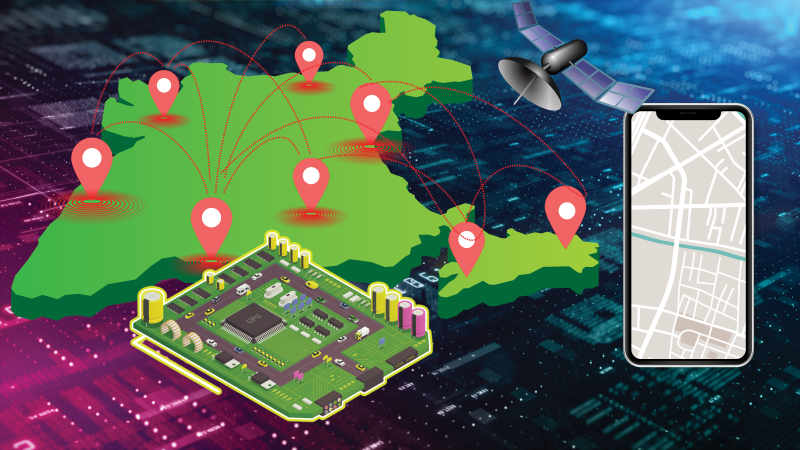
Location services have become an essential part of everyone's life, particularly for navigation using mobile phones. The popular location service is the Global Positioning System (GPS), a satellite-based navigation system owned by the United States of America. However, access to GPS is controlled by the government of the USA not always guaranteed. For instance, the USA did not allow the Indian Armed Forces to use GPS during the Kargil war. This prompted the Government of India to develop its own indigenous satellite navigation system, NAVIC.
Working towards Atma Nirbhar Bharat, NAVIC (NAVigation with Indian Constellation) is an indigenously developed satellite navigation system by India that provides reliable access across the Indian sub-continent. This constellation provides accurate position information service to users within India as well as the region extending up to 1,500 km from its boundary, which is its primary service area. It also provides limited service beyond this region. The system can be used for terrestrial, aerial and marine navigation; disaster management; vehicle tracking and fleet management; visual and voice navigation for drivers; integration with mobile phones; mapping and geodetic data capture; visual and voice navigation for drivers; integration with mobile phones; mapping and geodetic data capture; location-based services; search and rescue services; visual and voice navigation for drivers.
However, none of the mobile manufacturers has incorporated NAVIC as a mainstream choice of a positioning system yet. Currently, there doesn’t exist a single unified solution that can receive all bands of NAVIC as well as various other Global Navigation Satellite Systems. This motivated Prof. Rajesh Harishchandra Zele and his team at IIT Bombay to develop a NAVIC capable RF receiver called DHRUVA.
Dhruva sows seeds of development for high-performance RF ICs in India, for India. Dhruva is the first indigenously designed navigation receiver chip to work for all navigation frequency bands of NAVIC (L5 & S) and GPS (L1 & L2). It is a starting point to become self-reliant in this high-end technology area. Several PhD and MTech students are extensively trained to take circuit ideas from design conception to chip fabrication and testing. This is one of the most important missions under the Fabless Chip Design initiative by the Government of India.
Coming up with such an IC had several challenges to be overcome. The signals received are very weak compared to the ambient noise. Thus, the receiver must eliminate all the interfering signals, sifting out the weak desired navigation signals, then amplifying them by almost 400,000 times and then digitizing the analogue signals using on-chip Analog to Digital Converters. The digital signal processor on DHRUVA processes the digital signals to determine the user's location.
Various circuit design innovations in Dhruva resulted in the development of a production-ready receiver chip with robust performance over extreme temperature conditions.
A novel, compact, reconfigurable, on-chip frequency synthesizer for navigation receivers is proposed. The synthesizer is based on a voltage-controlled oscillator (VCO) with an on-chip frequency multiplier. A novel control scheme is proposed, which enables the use of a single VCO to synthesize multiple RF frequencies. A high-performance, low phase noise VCO with improved temperature characteristics is designed. The VCO operates over a wide temperature range of -40 to +125 degrees Celsius. The VCO operates at a supply voltage of 1.8 V and consumes only 1.5 mW from a 3 V supply. The synthesizer can be used in navigation receivers to synthesize multiple RF frequencies for navigation signals from the same chip.
In addition, a unique, compact, fully integrated, variable gain amplifier (VGA) for navigation receivers is designed in 65 nm CMOS technology occupying an active die area of 1.96 square mm. A new wideband input matched single to differential LNA with the on-chip harmonic matching network is proposed to avoid external balun and matching networks in the front-end module of the receiver. An original DC offset correction circuit is also proposed which cancels the DC offset in the LNA output by using an on-chip voltage-controlled current source (VCIS).
Thus, the receiver is fully integrated with no external components, making it suitable for easy integration into System on a Chip for large-scale deployment in commercial applications such as vehicle tracking, marine vessel tracking, rail/road/water transportation monitoring, and other navigation applications and consumer electronics products such as mobile phones and tablets. With the achieved specifications, the VGA is suitable for navigation using IRNSS, GPS, Galileo, and Beidou signals.
The development of this chip is a shot in the arm for indigenous technology development activities that could potentially guide in a host of applications, particularly navigation.
Editor’s Note: This is part of the special lab stories feature we are bringing to you.






